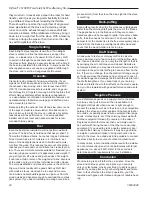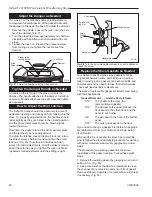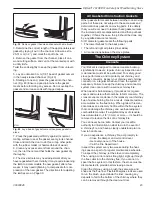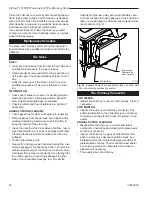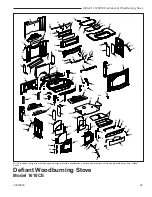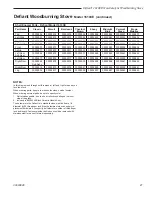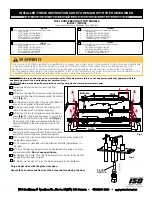
16
Defiant
®
1610CE Non-Catalytic Woodburning Stove
30003846
agement information on Page 6 to see how the size,
type, and location of your chimney will affect your stove
operation. When thermometer readings drop below
175° C (350° F) it is time to adjust the air control for a
higher burn rate or to reload the stove. A temperature
reading over 385° C (750° F) is a sign to cut back on
the air supply to slow the burn rate.
Use the following temperature ranges as a guide:
•
Readings in the 175°-60° C (350°-500° F) range
indicate low to medium heat output.
•
60°-315° C
(
500°-600° F) readings indicate me-
dium heat output.
•
Readings of 315-385° C (600°-750° F) indicate high
heat output. Operating your Defiant continuously at
griddle temperatures of 385° C (750° F) or higher
may damage the cast iron or enamel finish.
Use the air control Settings
that work best for you
No single air control setting will fit every situation. Each
installation will differ depending on the quality of the
fuel, the amount of heat desired, and how long you wish
the fire to burn; outdoor air temperature and pressure
also affect draft.
The control setting also depends on your particular
installation’s “draft,” or the force that moves air from the
stove up through the chimney. Draft is affected by such
things as the length, type, and location of the chimney,
local geography, nearby obstructions, and other factors.
See Page 7 for details on how the installation affects
performance.
Too much draft may cause excessive temperatures in
the Defiant, and could even damage the stove. On the
other hand, too little draft can cause backpuffing into
the room and/or the “plugging” of the chimney.
How do you know if your draft is excessively high or
low? Symptoms of too much draft include an uncontrol-
lable burn or a glowing-red stove part. Signs of weak
draft are smoke leaking into the room through the stove
or chimney connector joints or low heat output.
In some newer homes that are well-insulated and
weather-tight, poor draft may result from an insufficient
air supply in the house. In such instances, an open
window near the stove on the windward side of the
house can provide the combustion air supply needed.
Refer to Section of Document J which requires an
outside air vent for appliances with power outputs
above 5 kW. Always refer to national and local codes to
determine your specific requirements.
The Defiant NC is equipped to deliver outside air for
combustion and outside air kit #365 is available.
When first using the stove, keep track of the air control
settings. You will quickly find that a specific setting will
give you a fixed amount of heat. It may take a week or
two to determine the amount of heat and the length of
burn you should expect from various settings.
Most installations do not require a large amount of
combustion air, especially if adequate draft is available.
Do not for any reason attempt to increase the firing
of your heater by altering the air control adjustment
range outlined in these directions.
Use the following air control settings as a starting point
to help determine the best settings for your installation.
Each is described as a fraction of the total distance the
lever may be moved from right to left.
Defiant control Settings
(Refer to Figure 7, Page 19)
burn Rate
primary air control
Low
From far right to 1/3 the distance
to left
Medium
From 1/3 to /3 the distance
to left
High
From /3 the distance
to left, to far left
Do NoT opeRaTe The STove wiTh The aSh
DooR opeN. opeRaTioN wiTh The aSh DooR
opeN caN caUSe aN oveRFiRiNg coNDiTioN
To occUR. oveRFiRiNg The STove iS DaNgeR-
oUS aND caN ReSUlT iN pRopeRTy DaMage,
iNjURy oR loSS oF liFe.
conditioning your Stove
Cast iron is extremely strong, but it can be broken with
a sharp blow from a hammer or from the thermal shock
of rapid and extreme temperature change.
The cast plates expand and contract with changes in
temperature. When you first begin using your Defiant,
minimize thermal stress by letting the plates adjust
gradually during three or four initial break-in fires follow-
ing Steps 1-3 below.
Starting and Maintaining a wood Fire
Burn only solid wood in the Defiant, and burn it directly
on the grate. Do not elevate the fuel. Do not burn coal
or other fuels.
The bypass damper must be open when starting a
fire or when refueling.
Do not use chemicals or fluids to start the fire. Do
not burn garbage. Never use flammable fluids such
as gasoline, gasoline type lantern fuel, kerosene,
charcoal lighter fluid, naptha, engine oil or similar
liquids to start or “freshen up” a fire in this heater.
keep all such liquids well away from the heater
while it is in use.



















